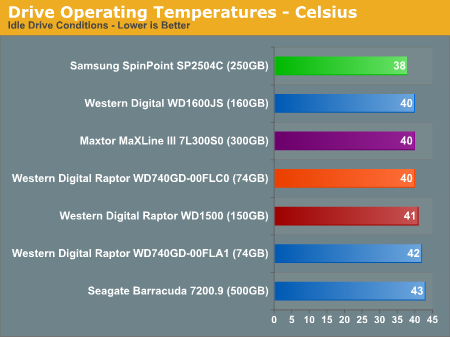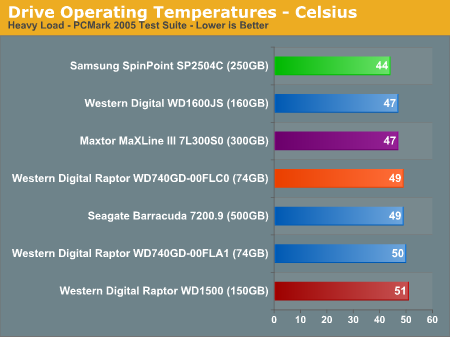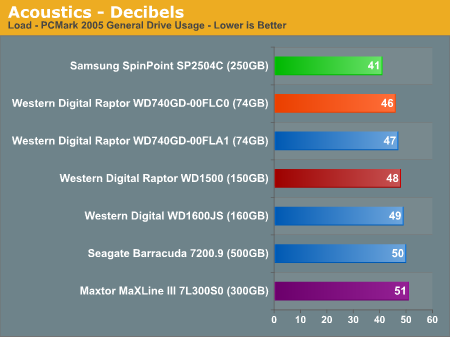Western Digital WD1500ADFD: King Raptor
by Gary Key on February 8, 2006 1:30 AM EST- Posted in
- Storage
Hard Drive Performance: Thermal and Acoustics
We have revised our acoustics testing for this article. Our acoustic test utilizes our standard test bed components, but we installed our Thermaltake water-cooling system for the CPU and turned off the case fans to isolate as much case noise as possible during testing. Our OCZ power supply is virtually silent in these tests and we installed our fanless Gigabyte 6600GT video card to further reduce noise.
Our acoustic tests are designed to measure the decibel levels while the system is at idle and also under load while running the General Hard Disk Drive Usage benchmark within PCMark 2005. We found through trial and error that this particular benchmark produces controlled readings across a wide range of applications within the benchmark. This particular benchmark utilizes 60% reads and 40% writes within the trace playback file.
The measurements are taken at a distance of 5 millimeters from the rear and front of the drive being tested in order to minimize surrounding environmental noise. The reported measurements are based on an A-weighted decibel score that measures frequencies similar to the way that the human ear responds to sound. We take a total of 5 measurements for each test. We subtract the high and low scores and then average the middle three to arrive at our findings.
Our thermal tests continue to utilize sensor readings via the S.M.A.R.T. technology on the drives. We will move to an infrared thermometer testing procedure in the near future to supplement the current test procedures.
The thermal characteristics of both Raptors were very close with the WD1500 running slightly hotter under the load conditions. While we did not report the infrared test results in this article, the heat sink fan area on the Raptors reached temperatures around 55c during the load testing. Of course, these temperatures would be reduced with the case fans running, but it is something to be aware of if you plan on utilizing the drive in a SFF case.
The acoustical characteristics of both Raptors were similar. You will notice a slight whine during the spin-up phase on each drive along with the same whine when the drive powers down. The reads are clearly audible, but do not have the same metallic noise that we noticed on the Maxtor drives. During normal operations, both drives could be heard, but the sounds emitting from the drive was almost dull compared to the Maxtor drives. The WD1500 was slightly louder during constant read access compared to the WD740GD. While not obtrusive in our opinion, the sound levels would be clearly evident in a silent system.
We have revised our acoustics testing for this article. Our acoustic test utilizes our standard test bed components, but we installed our Thermaltake water-cooling system for the CPU and turned off the case fans to isolate as much case noise as possible during testing. Our OCZ power supply is virtually silent in these tests and we installed our fanless Gigabyte 6600GT video card to further reduce noise.
Our acoustic tests are designed to measure the decibel levels while the system is at idle and also under load while running the General Hard Disk Drive Usage benchmark within PCMark 2005. We found through trial and error that this particular benchmark produces controlled readings across a wide range of applications within the benchmark. This particular benchmark utilizes 60% reads and 40% writes within the trace playback file.
The measurements are taken at a distance of 5 millimeters from the rear and front of the drive being tested in order to minimize surrounding environmental noise. The reported measurements are based on an A-weighted decibel score that measures frequencies similar to the way that the human ear responds to sound. We take a total of 5 measurements for each test. We subtract the high and low scores and then average the middle three to arrive at our findings.
Our thermal tests continue to utilize sensor readings via the S.M.A.R.T. technology on the drives. We will move to an infrared thermometer testing procedure in the near future to supplement the current test procedures.




The thermal characteristics of both Raptors were very close with the WD1500 running slightly hotter under the load conditions. While we did not report the infrared test results in this article, the heat sink fan area on the Raptors reached temperatures around 55c during the load testing. Of course, these temperatures would be reduced with the case fans running, but it is something to be aware of if you plan on utilizing the drive in a SFF case.
The acoustical characteristics of both Raptors were similar. You will notice a slight whine during the spin-up phase on each drive along with the same whine when the drive powers down. The reads are clearly audible, but do not have the same metallic noise that we noticed on the Maxtor drives. During normal operations, both drives could be heard, but the sounds emitting from the drive was almost dull compared to the Maxtor drives. The WD1500 was slightly louder during constant read access compared to the WD740GD. While not obtrusive in our opinion, the sound levels would be clearly evident in a silent system.










51 Comments
View All Comments
Gary Key - Monday, February 20, 2006 - link
Maybe we should do a RAID 5 test only.....the RAID 0 results are what you expect them to be at this time, very good in two system benchmarks but slower in a couple of games..... ;->
mlittl3 - Wednesday, February 8, 2006 - link
Here you go.http://www.gamepc.com/labs/view_content.asp?id=rap...">http://www.gamepc.com/labs/view_content.asp?id=rap...
http://www.tomshardware.com/2006/02/06/wd1500ad_ra...">http://www.tomshardware.com/2006/02/06/wd1500ad_ra...
Two articles with raid numbers.
Wesley Fink - Wednesday, February 8, 2006 - link
The THG review only compares a single 150 Raptor to a RAID 0 with slower drives, but it does use a few real-world benchmarks. The other review tests RAID 0 with these Raptors but only uses synthetic benchmarks. Synthetic benchmarks are useful, but they are only part of the performance picture. Results with real-world benchmarks - particularly in RAID 0 - are very different.Live - Wednesday, February 8, 2006 - link
The tests linked are not very good. GamePC uses synthetic benchmarks which are not indicative of real world desktop performance. The Iometer in particular is not useful for single user scenarios and never was. Basically Gamepc doesn’t know what they are doing (or since they sell the stuff maybe that’s just what they do...)We all RAID-O improves performance a lot in Synthetic benchmarks. It does however not do the same for real world tests and certainly not in a cost effective way. I highly doubt SATA or this new raptor changes that. But would be interesting nonetheless to see some tests on the matter.
rjm55 - Wednesday, February 8, 2006 - link
This is the best hard drive review I've seen on AT in a very long time. Great job, guys. The history of Raptors at the start was a nice touch to help me better understand what WD is doing. I also think this is the first drive review I have seen by Gary Key. Bring us some more like this one.Live - Wednesday, February 8, 2006 - link
I have to agree this was really a step up as far as hardrive reviews go. Nice to see you are improving your thermal and acoustics testing. Keep up the good work!!!Rolphus - Wednesday, February 8, 2006 - link
Agreed - great review, and it was really interesting and useful to get an understanding of the evolution of the product.My only question is, why wasn't Raptor+NCQ added as part of the multi-tasking tested? I can see that being a useful indicator of desktop performance, especially as dual-core CPUs become more prevalent.
Rolphus - Wednesday, February 8, 2006 - link
That would be multi-tasking tests. Only had one coffee so far.Gary Key - Wednesday, February 8, 2006 - link
We will be investigating the effects of NCQ in more detail in the near future. We are working on a revised benchmark suite that consists of more real world applications and varying multi-task scenarios.ohnnyj - Wednesday, February 8, 2006 - link
In some of the graphs there are two 74GB Raptors, are these two different revisions?John